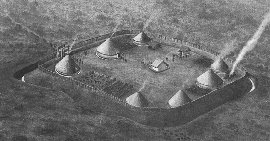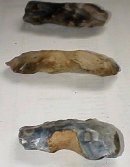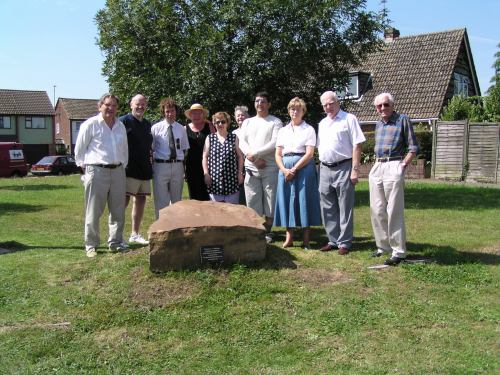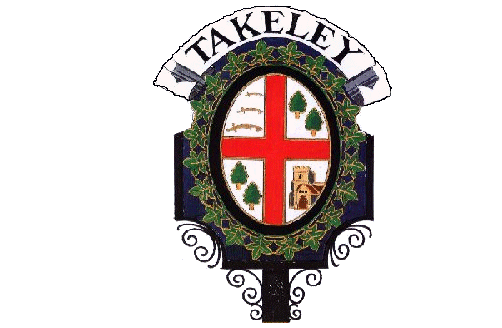|
During the expansion of Stansted airport in 1985, an archaeological dig took place on the site of what has become known as in-flight Catering Site. The dig was adjacent to the CAA Fire School training ground and is now covered by the cargo area.
Evidence of an Iron Age village built during the first century BC was uncovered, and described as the 'jewel in Stansted's crown' by Mr. Howard Brooks, the director of the archaeological project. The village, which covered an area of around 6,500 square metres, consisted of a dozen round thatch roof houses and a centrally placed shrine.


Among the many finds from this site were a hoard of 51 locally minted coins called "potin", Roman jewellery and brooches and a very large quantity of broken pottery, being fragments of bowls, dishes and pots.
A second major find he described as 'breathtaking', were two Roman burials found on the Duck End Car Park site, containing pewter, bronze, pottery and even unbroken glass objects. As a result of the work undertaken during the survey a mass of information was gathered about the way the area was farmed in Roman times. The archaeological dig also revealed, remains dating from the Bronze Age (around 1500 BC) through the Iron Age to the Romans and Medieval period. This gives credence to the age of Takeley as being over 3,500 years old. Further sites have also been identified as Iron Age/Roman and medieval to the north of Pincey Brook. The course of this brook as it passes north of the village has not changed since prehistoric times. The archaeological finds indicate that Takeley was of some importance and also points to a Roman villa somewhere within the parish. As Stansted Airport continues to grow, even more remains are being discovered. During the spring and summer of 2000, on a proposed car park site just north of Pincey Brook, early Bronze Age settlements were revealed. Other finds of interest were a Saxon house, Roman and Norman remains. These are being explored and recorded.
The discovery of these early settlements helps in explaining the origin of the name 'Takeley'. The report has as yet not been published but it is proving that Takeley originally emerged as a settlement once surrounded by forest: 'A settlement next to open forest!' Takeley.
More recent digs at a gravel pit excavation at Lower Bamber's Green for the new A120 have revealed a number of Roman/Medieval Kilns, possibly for pottery manufacture.

Iron Spearhead - Roman

Flint Axe heads - Bronze Age

Ceremonial Sarsen Stone - Middle Bronze Age
The Sarsen Stone has now been sited as a monument at the Four Ashes crossroads adjacent to the Takeley village sign and is pictured below at the unveiling ceremony on 19th July 2003.

Sarsens are isolated blocks of extremely tough sandstone which originated as a layer of sand on the surface of the Chalk. This layer was probably cemented about 20 million years ago forming an impersistent crust on the chalk surface which resisted erosion. Much later, probably during the Ice Age, the crust was broken up and when the Anglian ice sheet spread over the chalklands into Essex it carried with it many of the remaining blocks. When the ice melted it left behind a residue known as till which contained the sarsens and subsequent erosion of this till sheet has left these boulders isolated on the land surface.
Sarsens are relatively common in north Essex and have been employed by man as way markers for centuries; they also had religious significance. Up to now the earliest evidence in Essex that man was aware of these boulders and made use of them was in the construction of a Roman villa at Gestingthorpe. The Stansted Airport find is therefore of great interest as it is the first evidence that they were used during the Bronze Age, some 3,500 years ago, although for what purpose has yet to be established.
This Sarsen is very typical of sarsens in Essex. It is roughly square in plan (approx. 1 metre x 1 metre in size) and between 30 and 40 centimetres thick. It has very smooth and weathered upper and lower surfaces but the four edges are fracture surfaces, no doubt broken at the time of its transport during the Ice Age. In fact its shape clearly indicates that it was once part of a layer of silcrete of the same thickness.
A curious feature is a hole in one of the fracture surfaces approximately 2 centimetres in diameter and at least 10 centimetres deep. Sarsens often have holes which have been interpreted as originally containing roots of plants growing on the land surface at the time of its formation but these are not normally seen on the fracture surfaces. There was therefore speculation that it may be man-made. Further investigation has revealed that the hole is not straight but slightly curved. This, together with the fact that it is densely packed with clay, indicates that it is natural.
The Stansted stone was found within a pit dug on the site of a Middle Bronze Age village (C 1500-1200 BC) . The following is an extract from a recent report.
"On the Mid Stay Car Park, the settlement comprised a collection of houses within a fenced/hedged enclosure. The settlement focussed on a larger roundhouse provided with an elaborate entrance (comprising a wide corridor or chamber facing the main enclosure entrance). This probably acted as a communal building or the home of the
community's leader. A large glacial erratic (weighing over 1 tonne) was placed in a pit adjacent to the entrance to this building, possibly as a mark of the special status of this building. It was probably placed in the open pit, which gradually silted up around it. "
During the early Bronze Age (from around 2000BC) large quarried stones or sometimes glacial erratics were often set up as standing stones, either singularly or in groups (Stonehenge being the best example). We have recovered evidence of human activity at Stansted dating to this period and it might be that the stone was indeed the focus for some ceremonial or ritual activities prior to its burial within the later village. The stone had clearly been purposefully buried in the pit. Why we do not know. It would have been a lot easier to leave well alone so the expenditure of energy must have been for a good reason. However, even the fact of its burial suggests it still had some significance, or that the act of burial was in a sense a symbolic decommissioning. Who knows.
Whatever the original purpose behind the stone (and there may have been many) it now has new meaning as a symbol of the past rediscovered at Stansted.
|



